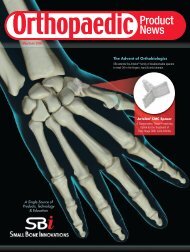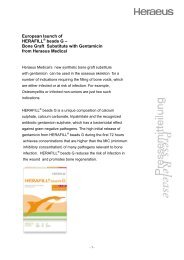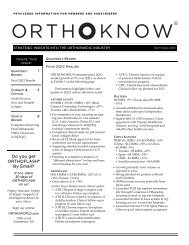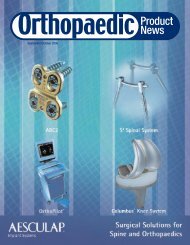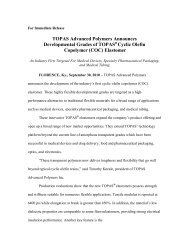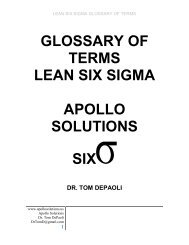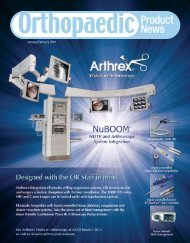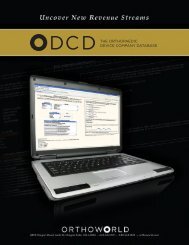Hip & Knee Surgery - Orthoworld
Hip & Knee Surgery - Orthoworld
Hip & Knee Surgery - Orthoworld
Create successful ePaper yourself
Turn your PDF publications into a flip-book with our unique Google optimized e-Paper software.
SURGEON AS ENTREPRENEURcontinued from page 52sible that an inventor filing an application today that is assigned toa non-participating Art Unit will still eventually be able to takeadvantage of the first action interview procedure. Recognizing thatsome surgery related patent applications will now be able to participatein the Enhanced First Action Interview Pilot Program, let usnow review the procedures and benefits offered by the initial pilotprogram and then turn our attention to the enhanced procedures,which have just become effective as of October 1, 2009.Prior to the initiation of the First Action Interview Pilot Programon April 28, 2008, the normal Patent Office policy was to not allowan examiner’s interview for the purpose of discussing patentabilitybefore the first Office Action on the merits,except in cases of a continuing or substituteapplications. The opportunity providedthrough the revised examiner’s interviewpolicy, as tested by the initial pilot program,improved the early communicationand understanding between the patentexaminer and the applicant and greatlyincreased the likelihood of an early andfavorable result of the patent prosecutionprocess.For those patent applications that arenot included in the pilot program, the filedapplication is presented to the patent examineronly as a printed application thatdescribes how to make and use the inventionin the specification and specificallydefines the invention to be protected in the claims section of theapplication. Until the advent of the initial pilot program, it wasaccepted that the examiner’s sole reliance on the application aswritten would be sufficient to support his complete understandingof the invention and no benefit of a personal exchange between theexaminer and the applicant was permitted. This expectation is reasonable,since the patent application to be in compliance with U.S.patent laws must teach how to make and use the invention so as toenable one of ordinary skill in the art to practice the invention.While legally correct, the expectation that the patent examiner willclearly and fully understand the invention as described andclaimed in the application after a first reading and examination is anaive understanding of what the initial examination of the applicationinvolves.Depending upon the technology and the complexity of a particularinvention, the written specification can be lengthy, complicatedand contain multiple embodiments of the invention in addition tothe required best mode envisioned by the patent applicant. In additionto reading the application, the examiner must determine all classificationswithin which to conduct his prior art search and mustthen carefully search for and study all possibly relevant prior artpublications before drafting his first written Office Action on themerits. Frequently, the blended technologies that contribute to thewhole invention will require the assigned patent examiner to consultwith patent examiners working in other unrelated Art Units andthen to conduct prior art searches in those ancillary technologyareas. An example of such a requirement might be a complex surgicalendoscopic instrument such as trocar that includes novelhydraulic fittings for irrigation and suction lumens, as well as opticsand laser capabilities included within the mechanical trocar device.Such an invention commonly requires that the assigned patentexaminer expand his search far beyond the typical surgical realm.Depending upon the current state of the technology involved and“The procedure for theEnhanced First ActionInterview Pilot Programoffers more benefitsand flexibilities to theparticipants than theinitial pilot program.”the volume of prior art that must be screened for relevance to theclaimed invention, this initial effort, if thoroughly done by the examiner,can require much more time than he is provided under the productivitypolicies of the Patent Office. The time allotted for an examinerto do his work varies by his area of technology and his level ofexperience, but in no case can the few hours provided by PatentOffice productivity policies be sufficient for the examiner to fullyunderstand all that is placed in front of him as well as it is understoodby the inventor and his attorney, who typically have spentmany times the number of hours inventing, testing and creating awritten application description of the invention. Under conventionalpatent prosecution policies, the examiner is denied the benefit ofinvolving these individuals who are much more familiar with theclaimed invention.In consideration of the extensive effortsrequired of a patent examiner for his initialstudy of a patent application, it is clear thatthe examiner will have some difficulty incoming to a full and accurate understandingof the written disclosure of the inventionrelative to the conventional prior artwhen so few hours are allotted. For this reason,it is common for the examiner’s firstOffice Action to be less precise and useful tothe patent prosecution process than it couldbe. Often it is the applicant’s response to thefirst Office Action that assists the examinerin coming to a better understanding of thedifferences between the claimed inventionand the prior art cited in the Office Action.As a result, the second Office Action can be researched and draftedby the examiner with greater clarity and precision. Because this secondOffice Action by the examiner is often a Final Office Action, theapplicant has only a limited possibility through the submission of anAfter Final Amendment to convince the examiner of the patentabilityof the claims. It is important to understand that the examiner hasthe option of denying entry of the After Final Amendment into thepatent application record. For this reason, the conventional patentexamination procedures where the examiner is forced to develop hisinitial understanding of the invention without benefit of communicatingwith the applicant often results in the applicant having a verylimited opportunity to convince the examiner of the patentability ofhis claimed invention.Patent Office policy currently permits an applicant to requestand be granted an interview with the examiner after the first OfficeAction on the merits. Often these Examiner’s Interviews prove veryhelpful because they afford an opportunity for the applicant tobring certain aspects of the invention, which may have been overlookedin the initial examination, to the examiner’s attention. Thepersonal interview, even if conducted telephonically, allows theinventor/applicant to discuss or to teach as necessary the criticalaspects of the invention that, while fully described in the writtenspecification, were not well understood or properly weighted bythe examiner during his initial and often hurried first look at thepatent application. The Examiner’s Interview allows an unfettereddiscussion of the essence of the invention, the reality of the prior art,and the applicant’s understanding of the patentable distinctionbetween them. It allows the examiner the opportunity to hear andunderstand precisely what the inventor discovered in the newinvention and to see that discovery through the inventor’s eyes.Frequently this dialogue, this exchange of view points, allows theinventor and examiner to come to a mutual understanding of whatcontinued on page 5554 ORTHOPAEDIC PRODUCT NEWS • November/December 2009



